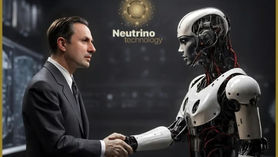Physical evidence and calculation principles of the power of fuel-free Neutrinovoltaic electric power generation
- https://www.techcult.ru/
- 6 hours ago
- 5 min read
The climate crisis caused by global change is becoming an increasingly serious threat to humanity. Climatologists from the University of Leeds have published a report that is alarming. They warn that if greenhouse gas emissions remain at the current level, the permissible carbon reserve will be exhausted within the next three to four years. This means that we are approaching a climate crisis that could lead to a significant increase in temperature and large-scale disasters.
In the current conditions, it is especially important to develop and implement fuel-free electricity generation technologies. In Russia, interest in these developments is still at an initial level, while abroad, impressive successes in research and application are evident. A striking example of this is the achievements of the Neutrino Energy group of companies, which developed a graphene technology for fuel-free electricity generation called Neutrinovoltaic. It is based on interdisciplinary innovations modelled by Holger Thorsten Schubart, a German mathematician and president of the Neutrino Energy group, through the interaction of particles from the invisible radiation spectrum with a composite multilayer nanomaterial consisting of 12-20 alternating layers of graphene and doped silicon (graphene 0.34 nm/layer, doped silicon 10-22 nm/layer).

Fuel-free graphene generators Neutrino Power Cubes. Source - website of the Neutrino Energy group of companies (https://neutrino-energy.com/chinese-newsroom )
The properties of these materials are given in the table.
Material type | Main parameters | The Role of Technology |
Single layer graphene | Electron mobility 2×10^5 cm^2/(V s) (100 times greater than silicon), response time < 1 ns, specific surface area 2630 m^2/g | Capture of tiny energies: sensitivity to neutrino scattering and muon ionization, energy conversion to lattice vibrations (phonon frequency 10^12-10^13 Hz) |
N-type doped silicon (phosphorus) | The charge carrier concentration is 10^16-10^18 cm^{-3}, the built-in electric field is 10^4-10^5 V/m, the recombination rate is < 10^3 cm^{-3}・s^{-1} | Directional charge transfer: suppresses electron-hole recombination and directs free electrons to form a stable current. |
Each graphene layer participates in the energy interaction while being in a 3D plane, so the efficiency of interaction with particles of the surrounding radiation fields per unit volume increases from 10^2 W/m^3 to 10^4 W/m^3 (an increase of 1–2 orders of magnitude) compared to a 2D plane. The advantages of Neutrinovoltaic’s “volumetric energy generation” can be quantified using the laws of physics. The basic formula is based on the laws of conservation of energy and the mechanisms of material interaction:
P(t) = η ∫V Φeff(r,t) · σeff(E) dV,where:
P(t) - Instantaneous power output
η - Overall conversion efficiency
V - Effective volume of electricity generation
Φamb(r,t) - Energy flux density at point r and time t
σeff(E) - Effective cross-section of material interaction for particles with energy E
E - Particle energy
The formula clearly demonstrates the difference between neutrinoenergetics and photovoltaics. Solar cells are area-dependent, while neutrinoenergetics is volume-dependent. Each cubic centimeter of the layered composite contributes to the power.
The equation shows that the power generated depends on η (it can be improved by optimizing the material), Φ (regional differences are less than 1%), and V (efficiency increases due to compact design). This highlights the advantage of neutrinoenergetics: no surface area limitations.
Graphene has an amazing electron mobility of over 200,000 cm^2/V s. This allows it to move charge quickly. Its phonon resonances are in the range of 10^12–10^13 Hz, which coincides with the oscillation frequencies caused by neutrinos. Doped silicon with a high carrier density (10^16–10^18 cm^{-3}) provides stable conductivity and built-in electric fields with a strength of 10^4–10^5 V/m. The dynamic properties of graphene promote the interaction of electric and magnetic fields, creating an electromotive force.
The formula P(t) = η ∫V Φeff(r,t) · σeff(E) dV is widely used in artificial intelligence (AI) programs. Artificial intelligence allows for the analysis of vast spaces of nanomaterial configurations with high accuracy and speed, which turns uncertain experiments into controlled, data-driven engineering activities. Neutrinovoltaics provides sustainability due to continuous operation in any environmental conditions, the absence of moving parts, and the generation of energy directly at the point of use. This eliminates systemic vulnerabilities.

Theoretical work in the field of Neutrinovoltaic power generation is carried out in parallel with its practical implementation in production. At this stage, 2 types of equipment have been developed and are being implemented, which are certified according to the IEC 63356-2024 standard:
Neutrino Power Cube, a 50 kg generating unit that produces 5-6 kW of clean power. The device does not contain moving parts, which reduces the need for maintenance. 200,000 of these cubes will create a total capacity of 1-1.2 GW, which is comparable to a VVER-1000 or VVER 1200 nuclear power plant unit. At the same time, they do not require a central location and are placed directly at the point of electricity consumption, which eliminates the need to transmit electricity through power lines.
The Neutrino Life Cube air conditioning system with the ability to generate electricity - weighs 80 kilograms and is equipped with a generator with a capacity of 1 to 1.5 kW. It also includes an air-to-water generator that produces 12 to 25 liters of water daily, depending on the air humidity. The device is easy to transport by car, it is ready to work immediately after installation. This makes it ideal for humanitarian operations, as well as in countries with a shortage of drinking water.
Examples of the use of the above fuel-free generators can be given:
In 2024, 20 Neutrino Power Cubes (with a total capacity of 100 kW) and 5 Neutrino Life Cubes were installed in the Kenyan village of Kisumu, where 500 people live. Every day, they produce 2,400 kWh of electricity in basic mode 24/7, meeting the needs of three clinics, two schools, and 50 small businesses. This led to noticeable social changes. Children's schooling increased from six to nine hours a day. The percentage of failed vaccinations decreased from 50 doses per month to zero. And the revenue of local workshops, such as a grain processing plant, tripled - from $1,500 to $5,000 per month.
In 2024, 50 Neutrino Life Cubes were used during rescue operations after wildfires in California. Each of these devices weighs 80 kg and can be quickly delivered to the site of an emergency by helicopter. They are ready to go just 10 minutes after opening the package. Each Neutrino Life Cube generates an average of 1.2 kW of electricity. This is enough to provide lighting and communication in a shelter for 20 people. In addition, it produces 12-25 liters of clean drinking water per day. During the 10 days without electricity, there was not a single failure, despite the fact that eight of the 20 diesel generators failed due to lack of fuel or blockages.
The presentation of the Pi Car electric vehicle concept with a built-in fuel-free graphene power generation system is expected soon, as well as new developments in the field of water and air transport. They are based on the formula P(t) = η ∫V Φeff(r,t) · σeff(E) dV and artificial intelligence for calculations.
The potential for using Neutrinovoltaic technology is endless. The traditional view of energy is focused on scarcity. It is believed that it must be produced centrally and transmitted over long distances. This leads to inaccessibility and high costs. Neutrinovoltaic changes this approach, focusing on abundance. Energy sources such as neutrinos and muons are widespread and inexhaustible. The sun will shine for another 5 billion years. This means that energy will no longer be a bottleneck for progress.
Authors: Holger Thorsten Schubart, mathematician, president of the Neutrino Energy group of companies, scientific director of the Neutrinovoltaic Technology project
Rumiantcev L.K., Ph.D., deputy chairman of the scientific advisory board of the Neutrino Energy group of companies























































Comments